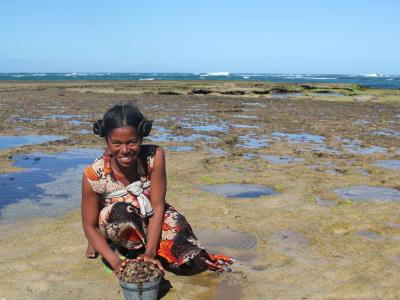New Readiness Programme launched in Madagascar to support adaptation planning

Madagascar has experienced a repetitive famine or “kéré” due to prolonged droughts occurring in southern part of the country. This has demonstrated that climate change should not be perceived as an environmental matter but rather as a crosscutting development issue. Climate change causes both seen and unseen changes to our ecosystem and threatens food security, as well as other sectors. Although only responsible for 0.01 percent of total global emissions[1], Madagascar already faces the adverse impacts of climate change, especially with regards to natural disasters. It was hit by two intense cyclones in 2004 and lost USD 1 billion in the period of 1980-2010 due to natural hazards[2]. The country is also home to a rich biodiversity with more than 80 percent of its plant and animal species being endemic to the country[3]. The unusual rate at which habitats are altered by climate change may threaten their existence on this planet.
Nearing the end of 2020, the Ministry of Environment and Sustainable Development (MEDD) in Madagascar and the United Nations Development Programme (UNDP) jointly organized the launch of a new Green Climate Fund (GCF)-financed programme “Medium term planning for adaptation in climate sensitive sectors in Madagascar”. The aim of this adaptation planning project under the Readiness programme is to support efforts made by the Government on climate change adaptation by producing knowledge, strengthening institutional capacities and leveraging funding opportunities. With a total budget of USD 1,3 million, the activities will be implemented for a duration of 18 months in the world’s fifth largest island.
 The launch was co-chaired by the Minister of MEDD, Ms. Baomiavotse Vahinala Raharinirina, and the UNDP Resident Representative, Ms. Marie Dimond. They both stressed the importance of the programme and the need to align it with national strategies, including the National climate change policy (PNLCC), the National adaptation action plan for climate change (PANLCC) and the National Adaptation Plan (NAP). The latter was presented at the COP 25 in December 2019, making Madagascar one of the first Least Developed countries (LDCs) to formulate a NAP.
The launch was co-chaired by the Minister of MEDD, Ms. Baomiavotse Vahinala Raharinirina, and the UNDP Resident Representative, Ms. Marie Dimond. They both stressed the importance of the programme and the need to align it with national strategies, including the National climate change policy (PNLCC), the National adaptation action plan for climate change (PANLCC) and the National Adaptation Plan (NAP). The latter was presented at the COP 25 in December 2019, making Madagascar one of the first Least Developed countries (LDCs) to formulate a NAP.
Although the NAP was a major milestone for Madagascar, national adaptation planning is still a process that goes beyond this achievement. It is a continuous cycle of planning, implementation and Monitoring and Evaluation (M&E) to adjust adaptation capabilities over time[4]. The Readiness programme will support the NAP process in Madagascar by addressing some of the remaining gaps. This includes funding further risk and vulnerability assessments to tackle the lack of knowledge on costs and benefits of adaptation in the most vulnerable sectors. The programme will also strengthen the capacity of existing institutional bodies in charge of coordinating the work on adaptation at the national level. An important component of the programme will focus on promoting private sector investments to cover the massive costs of climate adaptation actions in Madagascar, estimated to be USD 28,7 billion in its National Determined Contributions (NDCs)[5].
As emphasised during the launch, with limited funding available in the country to address the effect of climate change, synergies with other initiatives must be built to make the best use of resources. The Readiness programme will support the integration of adaptation into development planning to better coordinate the response at the national level and allocate funds efficiently. This is essential to refine Madagascans’ way of living in the long term and to take appropriate action to minimise the damage that climate change would cause. Lastly, the programme will contribute to the raised ambition under the adaptation component of Madagascar’s revised NDCs, which serve as a basis for national climate action plans and contributions at global level.
Story by Thibault Le Pivain, Project Support Officer in Climate Change Adaptation, UNDP with support from Melanie Pisano, Climate Change Communication Specialists, UNDP
Photo caption: The Minister of MEDD, Ms Baomiavotse Vahinala Raharinirina (left), and the UNDP Resident Representative, Ms Marie Dimond (right), co-chairing the inception workshop of the Readiness programme. Photo Credit: UNDP Madagascar.
[1] Worldometer (2020). Madagascar CO2 emissions. URL: https://www.worldometers.info/co2-emissions/madagascar-co2-emissions/#:~:text=CO2%20emissions%20per%20capita%20in,in%20CO2%20emissions%20per%20capita.
[2] The Global Facility for Disaster Reduction and Recovery (GFDRR) (2018). Vulnerability, Risk Reduction, and Adaptation to Climate Change – Madagascar. URL: https://climateknowledgeportal.worldbank.org/sites/default/files/2018-10/wb_gfdrr_climate_change_country_profile_for_MDG.pdf.
[3]USAID (2014). Madagascar Environmental Threats and Opportunities Assessment 2014 Update. URL: https://usaidgems.org/documents/FAA&Regs/FAA118119/Madagascar2014.pdf.
[4] NAP Global Network (2020). The National Adaptation (NAP) Process: Frequently Asked Questions. URL: https://napglobalnetwork.org/wp-content/uploads/2020/08/napgn-en-2020-NAP-Process-FAQs.pdf.
[5] République de Madagascar (2015). Contribution Prévue Déterminée au niveau National (CPDN). URL : https://www4.unfccc.int/sites/ndcstaging/PublishedDocuments/Madagascar%20First/Madagascar%20INDC.pdf.
